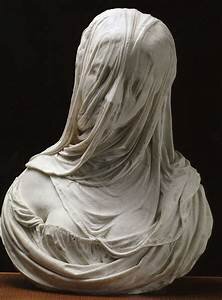The Beauty of Ambiguity
Please view the video below, read all the information under the video, complete the assessment, and assignment below. You have two weeks to complete this assignment. It is due on November 20th.
One word that describes beauty is ambiguity. The concept of ambiguity is generally contrasted with vagueness. Ambiguity leaves you wondering and exploring the truth of an idea or subject. In art it can mean the ambiguity of two opposites coming together to form one beautiful third element. Christo does this in his sculptures, great graffiti artists like Banksy does this as well. In this lesson we are going to see visual ambiguity in sculpture, the ambiguity of taking hard marble and turning it into thin cloth. The ambiguity of shrouding or hiding a beautiful subject as if the very veil could possibly be more beautiful than the subject or is it the other way around? That is ambiguity.
Many Italian artists specialized in producing a particular type of art, subject matter, or technique that proved to be very successful for them during their lifetime that of a veiled figure. When you see such masterpieces in person you find your breath is taken away in amazement. The subject matter of the art is not important but becomes secondary. There were several Italian sculpture artist’s that were able to produce such amazing pieces using a single theme of a veil or shroud, they were Gian Lorenzo Bernini, Giuseppe Croff, Giuseppe Sanmartino, and Raffaele Monti.
The Veiled Lady by Rafaello Moti
Bernini was the most accomplished and he produced detailed pieces that revealed texture within stone that depicts sheer amazement. Below are a brief introduction to these three artists and their work. Take your time to study each work and appreciate the beauty of each piece. When you are done with the reading be sure to complete the short assessment at the end of this page.
Raffaelo Monti
The Veiled Lady above is no one in particular. In fact, she exists only in your mind—a beautiful illusion, an elegant parlor trick, played by a sculptor to show off his skill. You can’t see through stone any more than you can saw a woman in half onstage. But tricks of light and polish, as well as the supple curves of the veil, suggest that you can. Veiled statues, widely produced in the 18th century and again in the 19th, were set on pedestals in the elegant homes of Europe as irresistible conversation pieces, anonymous beauties hiding behind a veil of virtuosity.
Raffaelo Monti was an artist that was born in Milan in 1818. This Italian born artist traveled learning from multiple artists whilst showing early promise. He was a poet, author and sculptor. His father Gaetano Matteo Monti was also a sculptor. Being as far back in history as he was it is hard to find aligning life histories of his life. What Monti is most known for was his renowned ability to convey the illusion of transparency in veiled marble figures. He did this in a way that made a hard substance as marble lightly veil a face and show the light features of a women.
We can’t see through stone, but through tricks of light and polish, Raffaelo Monti created the illusion that we can. On his Veiled Lady, the top of the head and shoulders are polished smooth, to reflect light. But where the veil falls across the face, the marble is less polished. It reflects less light, suggesting the texture of fabric. Sculptures of veiled figures peaked in popularity during the 1700s in Italy, an opportunity for sculptors to show their technical mastery over marble. About a century later, Raffaelo Monti and other artists such as Giuseppe Croff (Italian) revived this technically demanding tradition.
Bernini
Giuseppe Croff
The Veiled Christ (Italian: Cristo velato) is a 1753 marble sculpture by Giuseppe Sanmartino exhibited in the Cappella Sansevero, Naples.
Veiled Christ is considered one of the world's most remarkable sculptures, and legendarily thought to have been created by alchemy. Sculptor Antonio Canova, who tried to acquire the work, declared that he would willingly give up ten years of his life to produce a similar masterpiece.[1]
Raffaele Monti
Raffaele Monti- Close up of TheVeiled Vestal Virgin
The Veiled Vestal Virgin by Raffaele Monti, 1847
In Ancient Rome, the Vestals were virgin priestesses whose lives were dedicated to the goddess Vesta. They were tasked to look after the sacred fire burning on her altar in the temple of Vesta, and were regarded as fundamental to the safety of Rome. The discovery of a "House of the Vestals" in Pompeii in the 18th century made Vestals a popular subject matter in art over the following 50 years.
Your Assignments: Deadline: Due November 20th (Two Weeks)
There are three assignments.
#1. Complete the simple assessment below.
#2. Create two drawings attempting to copy two of the veiled figures above. Drag two of them to your desktop and print them out.
#3. Create your own veiled drawing using yourself or someone else. If you do not have a veil then draw in the image behind the veil as you think it would appear.
Total Assignments: Therefore, you will produce a total of 3 drawings and send in this one assessment below. Send your drawings to db.ihs@yahoo.com .










